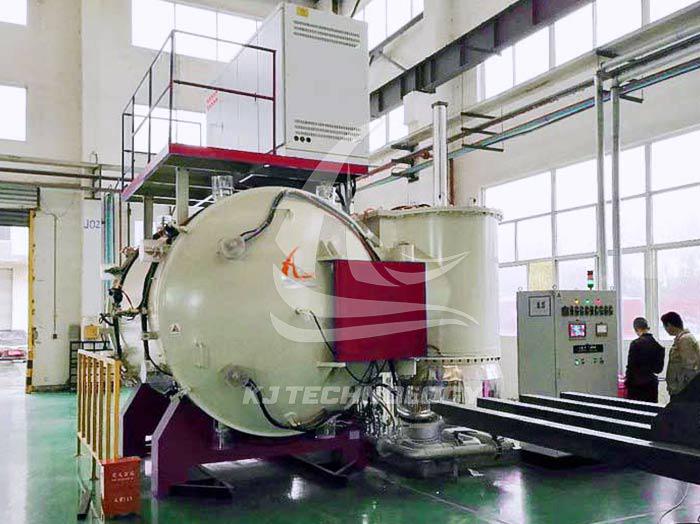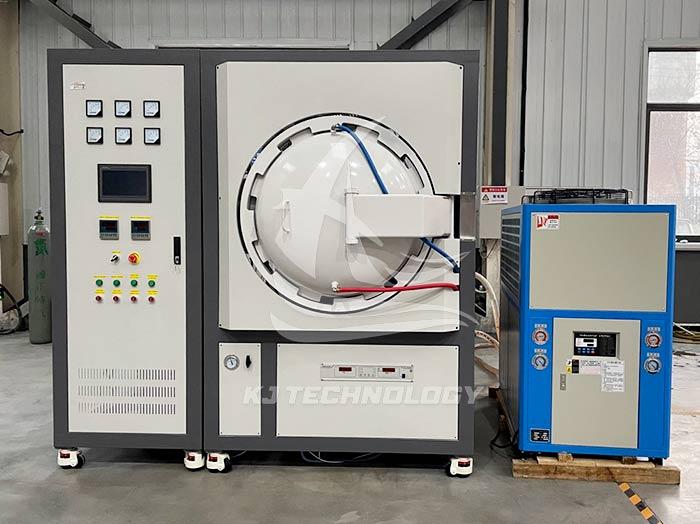Can a vertical vacuum hot press furnace pass gas?
 09-18-2025 Author: KJ technology
09-18-2025 Author: KJ technology
The vertical vacuum hot press furnace can pass gas, which is an important component of its design and can meet the special needs of various material sintering and process processing. The following is a detailed introduction to the ventilation function of the vertical vacuum hot press furnace:
1. The role of ventilation function
Create a protective or reactive atmosphere:
During the sintering process, introducing inert gases such as nitrogen and argon can create a protective atmosphere, preventing the material from reacting with oxygen, water vapor, etc. at high temperatures, thereby avoiding oxidation, volatilization, or performance degradation.
For certain materials that require a specific atmosphere to achieve sintering or reaction, such as silicon nitride, silicon carbide, etc., introducing a reaction gas (such as nitrogen) is an essential step.
Control furnace pressure:
By introducing gas, the pressure inside the furnace can be adjusted to meet the requirements of different material sintering or process treatments. For example, in the hot isostatic pressing (HIP) process, high temperature and high pressure need to be applied simultaneously, and it is necessary to increase the furnace pressure by introducing gas.
Promote gas escape and pore elimination:
In the early stage of sintering, there may be gas residues or pores inside the material. By introducing gas and applying pressure, the escape of gas and the elimination of pores can be promoted, thereby improving the density and performance of the material.
2. Implementation method of ventilation function
Gas supply system:
Vertical vacuum hot pressing furnaces are usually equipped with gas supply systems, including gas cylinders, pressure reducing valves, flow meters, and pipelines. These components work together to ensure stable and accurate gas flow into the furnace.
Gas cylinders are used to store gas, pressure reducing valves are used to regulate gas pressure, flow meters are used to control gas flow, and pipelines are used to transport gas into the furnace.
Air intake design:
There are usually specialized air inlets on the furnace body for connecting pipelines to the gas supply system. The design of the air inlet needs to consider the uniformity of gas distribution to ensure consistent gas concentration in various parts of the furnace.
Some vertical vacuum hot pressing furnaces are also equipped with multiple air inlets to adjust the gas inlet position and flow rate according to process requirements.
Vacuum and ventilation switching:
Vertical vacuum hot pressing furnaces usually have the function of switching between vacuum and ventilation. In the early stage of sintering, the air inside the furnace can be pumped out by a vacuum pump to create a high vacuum environment.
When gas needs to be introduced, the vacuum pump can be turned off and the gas supply system can be turned on to introduce gas into the furnace. This switching function allows for flexible adjustment of the furnace atmosphere according to process requirements.
3. Application case of ventilation function
Silicon nitride sintering:
During the sintering process of silicon nitride, nitrogen gas needs to be introduced as the reaction gas and protective atmosphere. Nitrogen can react with impurities in silicon nitride powder to generate stable compounds, thereby improving the purity of silicon nitride.
Meanwhile, nitrogen can also prevent silicon nitride from decomposing at high temperatures and maintain the stability of the material. By introducing nitrogen gas and applying pressure, high densification sintering of silicon nitride can be achieved.
Silicon carbide sintering:
Silicon carbide is prone to react with oxygen at high temperatures to produce silicon dioxide and carbon dioxide, leading to material performance degradation. Therefore, during the sintering process of silicon carbide, it is necessary to introduce inert gas (such as argon) as a protective atmosphere.
Inert gases can isolate oxygen and prevent the oxidation of silicon carbide. Meanwhile, by applying pressure, the bonding between silicon carbide particles can be promoted, improving the density and strength of the material.
4. Precautions for using ventilation function
Gas purity:
The gas introduced into the furnace needs to have high purity to avoid the influence of impurities on material properties. Therefore, when selecting gas cylinders and gas suppliers, it is necessary to ensure that the quality of the gas meets the process requirements.
Gas flow control:
The control of gas flow rate is crucial for the sintering process. Excessive flow may lead to uneven atmosphere or gas waste in the furnace; If the flow rate is too small, it may not be able to meet the process requirements. Therefore, it is necessary to precisely control the gas flow rate according to the process parameters.
Safe operation:
During the ventilation process, it is necessary to pay attention to safe operation. For example, when replacing gas cylinders or adjusting gas flow, it is necessary to first shut down the gas supply system and release the pressure inside the furnace to avoid danger.
At the same time, it is necessary to regularly check the sealing of the gas supply system to prevent gas leaks from causing safety accidents.








